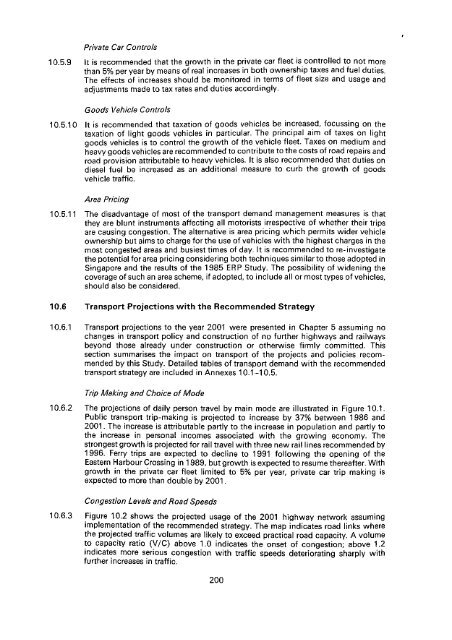Untitled - HKU Libraries - The University of Hong Kong
Untitled - HKU Libraries - The University of Hong Kong
Untitled - HKU Libraries - The University of Hong Kong
- No tags were found...
You also want an ePaper? Increase the reach of your titles
YUMPU automatically turns print PDFs into web optimized ePapers that Google loves.
Private Car Controls10.5.9 It is recommended that the growth in the private car fleet is controlled to not morethan 5% per year by means <strong>of</strong> real increases in both ownership taxes and fuel duties.<strong>The</strong> effects <strong>of</strong> increases should be monitored in terms <strong>of</strong> fleet size and usage andadjustments made to tax rates and duties accordingly.Goods Vehicle Controls10.5.10 It is recommended that taxation <strong>of</strong> goods vehicles be increased, focussing on thetaxation <strong>of</strong> light goods vehicles in particular. <strong>The</strong> principal aim <strong>of</strong> taxes on lightgoods vehicles is to control the growth <strong>of</strong> the vehicle fleet. Taxes on medium andheavy goods vehicles are recommended to contribute to the costs <strong>of</strong> road repairs androad provision attributable to heavy vehicles. It is also recommended that duties ondiesel fuel be increased as an additional measure to curb the growth <strong>of</strong> goodsvehicle traffic.Area Pricing10.5.11 <strong>The</strong> disadvantage <strong>of</strong> most <strong>of</strong> the transport demand management measures is thatthey are blunt instruments affecting all motorists irrespective <strong>of</strong> whether their tripsare causing congestion. <strong>The</strong> alternative is area pricing which permits wider vehicleownership but aims to charge for the use <strong>of</strong> vehicles with the highest charges in themost congested areas and busiest times <strong>of</strong> day. It is recommended to re-investigatethe potential for area pricing considering both techniques similar to those adopted inSingapore and the results <strong>of</strong> the 1985 ERP Study. <strong>The</strong> possibility <strong>of</strong> widening thecoverage <strong>of</strong> such an area scheme, if adopted, to include all or most types <strong>of</strong> vehicles,should also be considered.10.6 Transport Projections with the Recommended Strategy10.6.1 Transport projections to the year 2001 were presented in Chapter 5 assuming nochanges in transport policy and construction <strong>of</strong> no further highways and railwaysbeyond those already under construction or otherwise firmly committed. Thissection summarises the impact on transport <strong>of</strong> the projects and policies recommendedby this Study. Detailed tables <strong>of</strong> transport demand with the recommendedtransport strategy are included in Annexes 10.1-10.5.Trip Making and Choice <strong>of</strong> Mode10.6.2 <strong>The</strong> projections <strong>of</strong> daily person travel by main mode are illustrated in Figure 10.1.Public transport trip-making is projected to increase by 37% between 1986 and2001. <strong>The</strong> increase is attributable partly to the increase in population and partly tothe increase in personal incomes associated with the growing economy. <strong>The</strong>strongest growth is projected for rail travel with three new rail lines recommended by1996. Ferry trips are expected to decline to 1991 following the opening <strong>of</strong> theEastern Harbour Crossing in 1989, but growth is expected to resume thereafter. Withgrowth in the private car fleet limited to 5% per year, private car trip making isexpected to more than double by 2001.Congest/on Levels and Road Speeds10.6.3 Figure 10.2 shows the projected usage <strong>of</strong> the 2001 highway network assumingimplementation <strong>of</strong> the recommended strategy. <strong>The</strong> map indicates road links wherethe projected traffic volumes are likely to exceed practical road capacity. A volumeto capacity ratio (V/C) above 1.0 indicates the onset <strong>of</strong> congestion; above 1.2indicates more serious congestion with traffic speeds deteriorating sharply withfurther increases in traffic.200
















